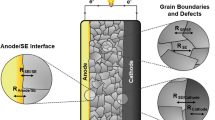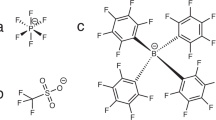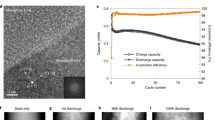Abstract
Solid-electrolyte interphase (SEI) films forming at the surface of anode electrodes are known as one of the crucial aspects that decide battery performance in most advanced battery technologies. For these films to be effective, ion transport and electron transport need to have specific properties. However, due to the difficulties accessing the dynamic character of SEI formation and evolution, little is known about these properties. Moreover, special multimodal techniques are needed to characterize the in situ behavior. Developing and designing these multimodal techniques with acceptable levels of control and reproducibility is a challenge. Here, using theory and computation, we focus on specific aspects of ion motion and charge transfer through a 1-nm-thick Li2S crystalline SEI obtaining important new insights regarding ion transport through nascent SEIs. Our study reveals that spontaneous ion hopping is the dominant mechanism for the motion of Li ions through a thin Li2S SEI located on top of Li metal. Simultaneously, charge transfer driven by the formation of a new Li2S layer due to reduction of a Li2S8 molecule from the electrolyte phase acts as a trigger of the ion transport process. Fluctuating charge transfer evolution appears as an exchange between pairs of metal layers, with maximum amplitudes observed at interfacial charge transfer through the Li metal/SEI interface.






Similar content being viewed by others
References
Lin Z, Liang C (2015) Lithium–sulfur batteries: from liquid to solid cells. J Mater Chem 3:936–958
Liu J, Bao Z, Cui Y, Dufek EJ, Goodenough JB, Khalifah P, Li Q, Liaw BY, Liu P, Manthiram A, Meng YS, Subramanian VR, Toney MF, Viswanathan VV, Whittingham MS, Xiao J, Xu W, Yang J, Yang X-Q, Zhang J-G (2019) Pathways for practical high-energy long-cycling lithium metal batteries. Nat Energy 4:180–186
Ma L, Cui J, Yao S, Liu X, Luo Y, Shen X, Kim J-K (2020) Dendrite-free lithium metal and sodium metal batteries. Energy Storage Mater 27:522–554
Lai J, Xing Y, Chen N, Li L, Wu F, Chen R (2020) Electrolytes for rechargeable lithium–air batteries. Angew Chem Int Ed 59:2974–2997
Bruce PG, Freunberger SA, Hardwick LJ, Tarascon J-M (2012) Li–O2 and Li–S batteries with high energy storage. Nat Mater 11:19–29
Chung S-H, Manthiram A (2019) Current status and future prospects of metal–sulfur batteries. Adv Mater 31:1901125
Yin Y-X, Xin S, Guo Y-G, Wan L-J (2013) Lithium–sulfur batteries: electrochemistry, materials, and prospects. Angew Chem Int Ed 52:13186–13200
Xu G, Ding B, Pan J, Nie P, Shen L, Zhang X (2014) High performance lithium–sulfur batteries: advances and challenges. J Mater Chem A 2:12662–12676
Chen L, Shaw LL (2014) Recent advances in lithium–sulfur batteries. J Power Sources 267:770–783
Ma G, Wen Z, Wu M, Shen C, Wang Q, Jin J, Wu X (2014) A lithium anode protection guided highly-stable lithium–sulfur battery. Chem Commun 50:14209–14212
Kumar R, Liu J, Hwang J-Y, Sun Y-K (2018) Recent research trends in Li–S batteries. J Mater Chem A 6:11582–11605
Cheng X-B, Huang J-Q, Peng H-J, Nie J-Q, Liu X-Y, Zhang Q, Wei F (2014) Polysulfide shuttle control: towards a lithium-sulfur battery with superior capacity performance up to 1000 cycles by matching the sulfur/electrolyte loading. J Power Sources 253:263–268
Hofmann AF, Fronczek DN, Bessler WG (2014) Mechanisticmodeling of polysulfide shuttle and capacity loss in lithium-sulfurbatteries. J Power Sources 259:300–310
Barchasz C, Molton F, Duboc C, Leprêtre J-C, Patoux S, Alloin F (2012) Lithium/sulfur cell discharge mechanism: an original approach for intermediate species identification. Anal Chem 84:3973–3980
Barghamadi M, Kapoor A, Wen C (2013) A Review on Li-S Batteries as a high efficiency rechargeable lithium battery. J Electrochem Soc 160:A1256–A1263
Wang W, Yue X, Meng J, Wang J, Wang X, Chen H, Shi D, Fu J, Zhou Y, Chen J, Fu Z (2019) Lithium phosphorus oxynitride as an efficient protective layer on lithium metal anodes for advanced lithium-sulfur batteries. Energy Storage Mater 18:414–422
Cheng X-B, Zhang R, Zhao C-Z, Wei F, Zhang J-G, Zhang Q (2016) A review of solid electrolyte interphases on lithium metal anode. Adv Sci 3:1500213
Shan X, Zhong Y, Zhang L, Zhang Y, Xia X, Wang X, Tu J (2021) A brief review on solid electrolyte interphase composition characterization technology for lithium metal batteries: challenges and perspectives. J Phys Chem C 125:19060–19080
Wang J, Ge B, Li H, Yang M, Wang J, Liu D, Fernandez C, Chen X, Peng Q (2021) Challenges and progresses of lithium-metal batteries. Chem Eng J 420:129739
Liu B, Zhang JG, Xu W (2018) Advancing lithium metal batteries. Joule 2:833–845
Fang C, Wang X, Meng YS (2019) Key Issues hindering a practical lithium-metal anode. Trends Chem 1:152–158
Chen X, Hou T, Persson KA, Zhang Q (2019) Combining theory and experiment in lithium–sulfur batteries: current progress and future perspectives. Mater Today 22:142–158
Tripathi AM, Su W-N, Hwang BJ (2018) In situ analytical techniques for battery interface analysis. Chem Soc Rev 47:736–851
Shutthanandan V, Nandasiri M, Zheng J, Engelhard MH, Xu W, Thevuthasan S, Murugesan V (2019) Applications of XPS in the characterization of battery materials. J Electron Spectrosc Relat Phenom 231:2–10
Nelson J, Misra S, Yang Y, Jackson A, Liu Y, Wang H, Dai H, Andrews JC, Cui Y, Toney MF (2012) In operando X-ray diffraction and transmission X-ray microscopy of lithium sulfur batteries. J Am Chem Soc 134:6337–6343
Kamphaus EP, Angarita-Gomez S, Qin X, Shao M, Engelhard M, Mueller KT, Murugesan V, Balbuena PB (2019) Role of inorganic surface layer on solid electrolyte interphase evolution at Li-metal anodes ACS Appl Mater Interfaces 11:31467–31476
Kamphaus EP, Gomez SA, Qin X, Shao M, Balbuena PBJC (2020) Effects of solid electrolyte interphase components on the reduction of LiFSI over lithium metal Chem Phys Chem 21:1310–1317
Kamphaus EP, Balbuena PB (2021) Polysulfide reduction and Li2S phase formation in the presence of lithium metal and solid electrolyte interphase layer. J Power Sources 485:229289
Ospina Acevedo F, Guo N, Balbuena PB (2020) Lithium oxidation and electrolyte decomposition at Li-metal/liquid electrolyte interfaces. J Mater Chem A 8:17036–17055
Angarita-Gomez S, Balbuena PB (2020) Insights into lithium ion deposition on lithium metal surfaces. Phys Chem Chem Phys 22:21369–21382
Angarita-Gomez S, Balbuena PB (2021) Solvation vs. surface charge transfer: an interfacial chemistry game drives cation motion. Chem Comm 57:6189–6192
Shi SQ, Lu P, Liu ZY, Qi Y, Hector LG, Li H, Harris SJ (2012) Direct calculation of Li-ion transport in the solid electrolyte interphase. J Am Chem Soc 134:15476–15487
Benitez L, Seminario JM (2017) Ion diffusivity through the solid electrolyte interphase in lithium-ion batteries. J Electrochem Soc 164 E3159
Kang D, Xiao M, Lemmon JP (2021) Artificial solid-electrolyte interphase for lithium metal batteries. Batteries Supercaps 4:445–455
Fan L, Zhuang HL, Gao L, Lu Y, Archer LA (2017) Regulating Li deposition at artificial solid electrolyte interphases. J Mater Chem A 5:3483–3492
Winter M (2009) The solid electrolyte interphase - the most important and the least understood solid electrolyte in rechargeable Li batteries. Z Phys Chem 223:1395–1406
Kresse G, Furthmuller J (1996) Efficiency of ab-initio total energy calculations for metals and semiconductors using a plane-wave basis set. Comput Mater Sci 6:15–50
Kresse G, Hafner J (1993) Ab initio molecular dynamics for liquid metals. Phys Rev B 47:558
Kresse G, Hafner J (1994) Ab initio molecular-dynamics simulation of the liquid-metal–amorphous-semiconductor transition in germanium. Phys Rev B 49:14251–14269
Blöchl PE (1994) Projector augmented-wave method. Phys Rev B 50:17953
Kresse G, Joubert D (1999) From ultrasoft pseudopotentials to the projector augmented-wave method. Phys Rev B 59:1758–1775
Perdew JP, Burke K, Ernzerhof M (1996) Generalized gradient approximation made simple. Phys Rev Lett 77:3865–3868
Monkhorst HJ, Pack JD (1976) Special points for Brillouin-zone integrations. Phys Rev B 13:5188–5192
Tang W, Sanville E, Henkelman G (2009) A grid-based Bader analysis algorithm without lattice bias. J Phys: Condens Matter 21:084204
Henkelman G, Arnaldsson A, Jónsson H (2006) A fast and robust algorithm for Bader decomposition of charge density. Comput Mater Sci 36:354–360
Ciccotti G, Ferrario M (2004) Blue moon approach to rare events. Mol Simul 30:787–793
Komeiji Y (2007) Implementation of the blue moon ensemble method. Chem-Bio Inf J 7:12–23
Bucko T (2008) Ab initio calculations of free-energy reaction barriers. J Phys Condens Matter 20:064211
Giannini M, Mastouri A, Demortière A, Dražić G, Davoisne C (2016) On the morphology of Li2S deposits in Li-S batteries. In European Microscopy Congress 2016: Proceedings pp 830–831
Wood KN, Teeter G (2018) XPS on Li-battery-related compounds: analysis of inorganic SEI phases and a methodology for charge correction. ACS Appl Energy Mater 1:4493–4504
Yemini R, Noked M (2021) Effect of polysulfide species on lithium anode cycle life and reversibility in Li–S batteries. ACS Appl Energy Mater 4:4711–4718
Eithiraj RD, Jaiganesh G, Kalpana G, Rajagopalan M (2007) First‐principles study of electronic structure and ground‐state properties of alkali‐metal sulfides – Li2S, Na2S, K2S and Rb2S. Phys Status Solidi B 244:1337–1346
Zhang K, Wang L, Hu Z, Cheng F, Chen J (2014) Ultrasmall Li2S nanoparticles anchored in graphene nanosheets for high-energy lithium-ion batteries. Sci Rep 4:6467
Funding
This work was supported by the Assistant Secretary for Energy Efficiency and Renewable Energy, Office of Vehicle Technologies of the US Department of Energy through the Advanced Battery Materials Research (BMR) Program (Battery500 Consortium phase 2) under DOE contract No. DE-AC05-76RL01830 from the Pacific Northwest National Laboratory (PNNL). Computational resources from the Texas A&M University High Performance Research Computing are gratefully acknowledged.
Author information
Authors and Affiliations
Corresponding author
Ethics declarations
Conflict of interest
The authors declare no competing interests.
Additional information
We dedicate this paper to Prof. Doron Aurbach, for his extraordinary contributions to the understanding of battery materials and devices.
Publisher's Note
Springer Nature remains neutral with regard to jurisdictional claims in published maps and institutional affiliations.
Rights and permissions
About this article
Cite this article
Angarita-Gomez, S., Balbuena, P.B. Ion motion and charge transfer through a solid-electrolyte interphase: an atomistic view. J Solid State Electrochem 26, 1931–1939 (2022). https://doi.org/10.1007/s10008-022-05227-6
Received:
Revised:
Accepted:
Published:
Issue Date:
DOI: https://doi.org/10.1007/s10008-022-05227-6




